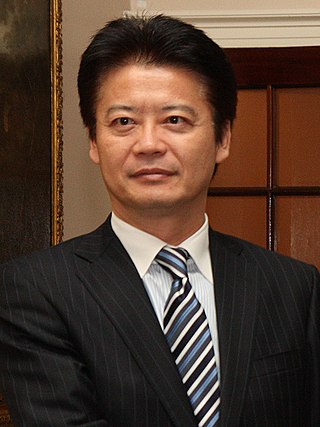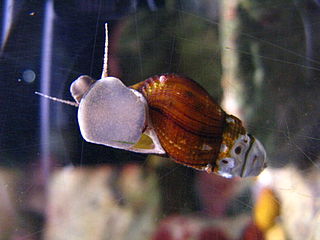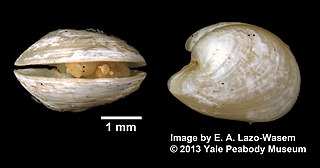Related Research Articles

Gastropods, commonly known as slugs and snails, belong to a large taxonomic class of invertebrates within the phylum Mollusca called Gastropoda.

Cymbopogon, also known as lemongrass, barbed wire grass, silky heads, oily heads, Cochin grass, Malabar grass, citronella grass or fever grass, is a genus of Asian, African, Australian, and tropical island plants in the grass family. Some species are commonly cultivated as culinary and medicinal herbs because of their scent, resembling that of lemons . The name cymbopogon derives from the Greek words kymbe and pogon "which mean [that] in most species, the hairy spikelets project from boat-shaped spathes." Lemongrass and its oil are believed to possess therapeutic properties.

The operculum is a corneous or calcareous anatomical structure like a trapdoor that exists in many groups of sea snails and freshwater snails, and also in a few groups of land snails; the structure is found in some marine and freshwater gastropods, and in a minority of terrestrial gastropods, including the families Helicinidae, Cyclophoridae, Aciculidae, Maizaniidae, Pomatiidae, etc.

Terrestrial animals are animals that live predominantly or entirely on land, as compared with aquatic animals, which live predominantly or entirely in the water, and amphibians, which rely on aquatic and terrestrial habitats. Some groups of insects are terrestrial, such as ants, butterflies, earwigs, cockroaches, grasshoppers and many others, while other groups are partially aquatic, such as mosquitoes and dragonflies, which pass their larval stages in water.

Amanita subjunquillea, also known as the East Asian death cap is a mushroom of the large genus Amanita, which occurs in East and Southeast Asia. Potentially deadly if ingested, it is closely related to the death cap A. phalloides.

Euhadra is a genus of air-breathing land snails, terrestrial pulmonate gastropod mollusks in the subfamily Bradybaeninae of the family Camaenidae.
Megalophaedusa spelaeonis, in Japanese: Kazaanagiseru, is a species of small, air-breathing land snail, terrestrial pulmonate gastropod mollusk in the family Clausiliidae, the door snails, all of which have a clausilium.
Nobuea is a genus of tropical land snails with an operculum, terrestrial gastropod mollusks in the family Cyclophoridae.

Kōichirō Genba is a Japanese politician who served as Minister for Foreign Affairs from 2011 to 2012. He is a member of the House of Representatives in the Diet, and was a member to the Democratic Party of Japan and its successor Democratic Party until its merger in 2018. He left the party briefly before the merger, and joined the Group of Independents House of Representatives caucus of other former Democrats a few days later. A native of Tamura, Fukushima and graduate of Sophia University, he was later accepted into the prestigious Matsushita Institute of Government and Management, an institution founded by Panasonic founder Konosuke Matsushita which grooms future civic leaders of Japan. Genba was elected to the House of Representatives for the first time in 1993 after serving in the assembly of Fukushima Prefecture for one term. In September 2011 he was chosen as Minister for Foreign Affairs in the cabinet of Prime Minister Yoshihiko Noda.
A valve is each articulating part of the shell of a mollusc or another multi-shelled animal such as brachiopods and some crustaceans. Each part is known as a valve or in the case of chitons, a "plate". Members of two classes of molluscs, the Bivalvia (clams) and the Polyplacophora (chitons), have valves.

Chrysomallon squamiferum, commonly known as the scaly-foot gastropod, scaly-foot snail, sea pangolin, or volcano snail is a species of deep-sea hydrothermal-vent snail, a marine gastropod mollusc in the family Peltospiridae. This vent-endemic gastropod is known only from deep-sea hydrothermal vents in the Indian Ocean, where it has been found at depths of about 2,400–2,900 m (1.5–1.8 mi). C. squamiferum differs greatly from other deep-sea gastropods, even the closely related neomphalines. In 2019, it was declared endangered on the IUCN Red List, the first species to be listed as such due to risks from deep-sea mining of its vent habitat.

Semisulcospira kurodai is a species of freshwater snail with an operculum, an aquatic gastropod mollusk in the family Semisulcospiridae. Prior to 2009, this species was classified in the family Pleuroceridae.

Juliidae, common name the bivalved gastropods, is a family of minute sea snails, marine gastropod mollusks or micromollusks in the superfamily Oxynooidea, an opisthobranch group.

Laevistrombus canarium is a species of edible sea snail, a marine gastropod mollusc in the family Strombidae. Known from illustrations in books dating from the late 17th century, L. canarium is an Indo-Pacific species occurring from India and Sri Lanka to Melanesia, Australia and southern Japan. The shell of adult individuals is coloured from light yellowish-brown to golden to grey. It has a characteristic inflated body whorl, a flared, thick outer lip, and a shallow stromboid notch. The shell is valued as an ornament, and because it is heavy and compact, it is also often used as a sinker for fishing nets.

Julia exquisita is a small species of sea snail with a green bivalve shell. It is a marine gastropod mollusk in the family Juliidae.

Julia japonica is a species of a sea snail with a shell comprising two separate hinged pieces or valves. It is a marine gastropod mollusk in the family Juliidae.
Julia mishimaensis is a species of a sea snail with a shell comprising two separate hinged pieces or valves. It is a marine gastropod mollusk in the family Juliidae.
Julia zebra is a species of a sea snail with a shell comprising two separate hinged pieces or valves. It is a marine gastropod mollusk in the family Juliidae.

Blanfordia is a genus of terrestrial gastropod mollusks in the family Pomatiopsidae. They are land snails which have an operculum.

The Ice Guy and His Cool Female Colleague is a Japanese manga series written and illustrated by Miyuki Tonogaya. It began serialization on Square Enix's Gangan Pixiv manga website in July 2019. As of June 2023, the series' individual chapters have been collected into eight volumes. An anime television series adaptation produced by Zero-G and Liber aired from January to March 2023.
References
- 1 2 (in Japanese) Sarma A. L. N. (1975) "東部インド洋産ユリヤガイ属及びタマノミドリガイ属の 3 新種 Three New Species of The Bivalved Gastropods Julia and Berthelinia Found in Eastern Indian Ocean". Venus: the Japanese journal of malacology34(1-2): 11-25. abstract
- ↑ Jensen K. R. (November 2007). "Biogeography of the Sacoglossa (Mollusca, Opisthobranchia)" Archived 2013-10-05 at the Wayback Machine . Bonner zoologische Beiträge 55(2006)(3-4): 255–281.